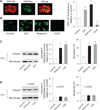Mechanisms regulating cytochrome c release in pancreatic mitochondria
- PMID: 18596195
- PMCID: PMC4551464
- DOI: 10.1136/gut.2007.147207
Mechanisms regulating cytochrome c release in pancreatic mitochondria
Abstract
Background: Mechanisms of acinar cell death in pancreatitis are poorly understood. Cytochrome c release is a central event in apoptosis in pancreatitis. Here, we assessed the regulation of pancreatic cytochrome c release by Ca(2+), mitochondrial membrane potential (Delta Psi m), and reactive oxygen species (ROS), the signals involved in acute pancreatitis. We used both isolated rat pancreatic mitochondria and intact acinar cells hyperstimulated with cholecystokinin-8 (CCK-8; in vitro model of acute pancreatitis).
Results: Micromolar amounts of Ca(2+) depolarised isolated pancreatic mitochondria through a mechanism different from the "classical" (ie, liver) mitochondrial permeability transition pore (mPTP). In contrast with liver, Ca(2+)-induced mPTP opening caused a dramatic decrease in ROS and was not associated with pancreatic mitochondria swelling. Importantly, we found that Ca(2+)-induced depolarisation inhibited cytochrome c release from pancreatic mitochondria, due to blockade of ROS production. As a result, Ca(2+) exerted two opposite effects on cytochrome c release: Ca(2+) per se stimulated the release, whereas Ca(2+)-induced depolarisation inhibited it. This dual effect caused a non-monotonous dose-dependence of cytochrome c release on Ca(2+). In intact acinar cells, cytochrome c release, caspase activation and apoptosis were all stimulated by ROS and Ca(2+), and inhibited by depolarisation, corroborating the findings on isolated pancreatic mitochondria.
Conclusions: These data implicate ROS as a key mediator of CCK-induced apoptotic responses. The results indicate a major role for mitochondria in the effects of Ca(2+ )and ROS on acinar cell death. They suggest that the extent of apoptosis in pancreatitis is regulated by the interplay between ROS, Delta Psi m and Ca(2+). Stabilising mitochondria against loss of Delta Psi m may represent a strategy to mitigate the severity of pancreatitis.
Figures









Comment in
-
A unique pancreatic mitochondrial response to calcium and its role in apoptosis.Gut. 2009 Mar;58(3):328-30. doi: 10.1136/gut.2008.160069. Gut. 2009. PMID: 19211852 No abstract available.
Similar articles
-
Prosurvival Bcl-2 proteins stabilize pancreatic mitochondria and protect against necrosis in experimental pancreatitis.Exp Cell Res. 2009 Jul 1;315(11):1975-89. doi: 10.1016/j.yexcr.2009.01.009. Epub 2009 Jan 24. Exp Cell Res. 2009. PMID: 19331832 Free PMC article.
-
Cholecystokinin induces caspase activation and mitochondrial dysfunction in pancreatic acinar cells. Roles in cell injury processes of pancreatitis.J Biol Chem. 2002 Jun 21;277(25):22595-604. doi: 10.1074/jbc.M202929200. Epub 2002 Apr 18. J Biol Chem. 2002. PMID: 11964411
-
Ca2+-induced reactive oxygen species production promotes cytochrome c release from rat liver mitochondria via mitochondrial permeability transition (MPT)-dependent and MPT-independent mechanisms: role of cardiolipin.J Biol Chem. 2004 Dec 17;279(51):53103-8. doi: 10.1074/jbc.M407500200. Epub 2004 Oct 8. J Biol Chem. 2004. PMID: 15475362
-
Mitochondrial function and malfunction in the pathophysiology of pancreatitis.Pflugers Arch. 2012 Jul;464(1):89-99. doi: 10.1007/s00424-012-1117-8. Epub 2012 Jun 1. Pflugers Arch. 2012. PMID: 22653502 Review.
-
Reactive oxygen species, Ca(2+) stores and acute pancreatitis; a step closer to therapy?Cell Calcium. 2016 Sep;60(3):180-9. doi: 10.1016/j.ceca.2016.04.007. Epub 2016 Apr 30. Cell Calcium. 2016. PMID: 27229361 Review.
Cited by
-
Review of experimental animal models of biliary acute pancreatitis and recent advances in basic research.HPB (Oxford). 2012 Feb;14(2):73-81. doi: 10.1111/j.1477-2574.2011.00408.x. HPB (Oxford). 2012. PMID: 22221567 Free PMC article. Review.
-
The crucial role of early mitochondrial injury in L-lysine-induced acute pancreatitis.Antioxid Redox Signal. 2011 Nov 15;15(10):2669-81. doi: 10.1089/ars.2011.4065. Epub 2011 Jul 18. Antioxid Redox Signal. 2011. PMID: 21644850 Free PMC article.
-
Organellar dysfunction in the pathogenesis of pancreatitis.Antioxid Redox Signal. 2011 Nov 15;15(10):2699-710. doi: 10.1089/ars.2011.4068. Epub 2011 Aug 11. Antioxid Redox Signal. 2011. PMID: 21834686 Free PMC article. Review.
-
Effects of oxidative alcohol metabolism on the mitochondrial permeability transition pore and necrosis in a mouse model of alcoholic pancreatitis.Gastroenterology. 2013 Feb;144(2):437-446.e6. doi: 10.1053/j.gastro.2012.10.037. Epub 2012 Oct 24. Gastroenterology. 2013. PMID: 23103769 Free PMC article.
-
Isorhamnetin Alleviates Mitochondrial Injury in Severe Acute Pancreatitis via Modulation of KDM5B/HtrA2 Signaling Pathway.Int J Mol Sci. 2024 Mar 28;25(7):3784. doi: 10.3390/ijms25073784. Int J Mol Sci. 2024. PMID: 38612598 Free PMC article.
References
-
- Gukovskaya AS, Pandol SJ. Cell death pathways in pancreatitis and pancreatic cancer. Pancreatology. 2004;4:567–586. - PubMed
-
- Halangk W, Lerch MM. Early events in acute pancreatitis. Clin Lab Med. 2005;25:1–15. - PubMed
-
- Kaiser AM, Saluja AK, Sengupta A, et al. Relationship between severity, necrosis, and apoptosis in five models of experimental acute pancreatitis. Am J Physiol Cell Physiol. 1995;269:C1295–C1304. - PubMed
-
- Gukovskaya AS, Perkins P, Zaninovic V, et al. Mechanisms of cell death after pancreatic duct obstruction in the opossum and the rat. Gastroenterology. 1996;110:875–884. - PubMed
-
- Sandoval D, Gukovskaya A, Reavey P, et al. The role of neutrophils and platelet-activating factor in mediating experimental pancreatis. Gastroenterology. 1996;111:1081–1091. - PubMed
Publication types
MeSH terms
Substances
Grants and funding
LinkOut - more resources
Full Text Sources
Medical
Research Materials
Miscellaneous
